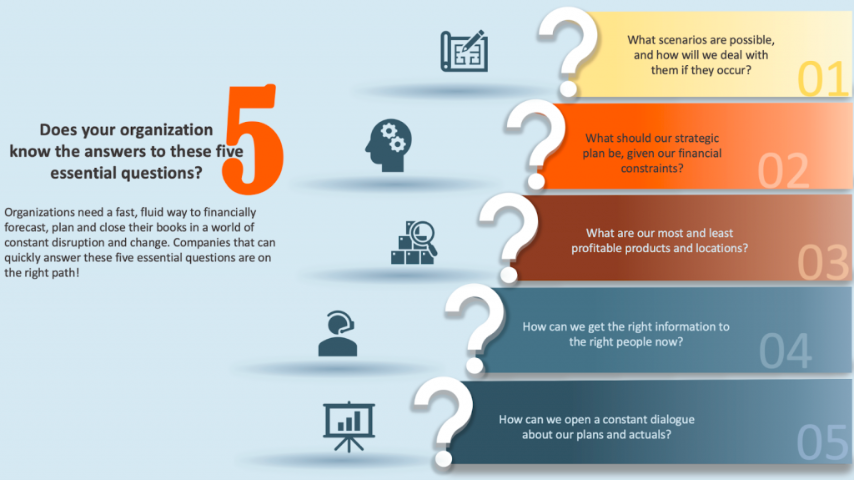The pandemic disruption put both the economy and corporate viability into a state of upheaval. It exposed vulnerability in a way not seen since the financial crisis of 2008. Sadly, many companies did not survive 2020 because their business model lacked the necessary financial reporting tools to enable the speed and agility necessary to respond during unprecedented times.
Billion-dollar bankruptcies among American companies hit a record high last year, with many citing pandemic-related factors as a cause. Of course, many were in financial trouble before the world came unhinged, but their inability to change course quickly sealed their fate, leaving a wake of lost profits, customers and jobs.
Yet there were also plenty of examples of how companies leaned into agility as never before, with quick pivots to respond to supply-chain upheaval, frightened workforces and increasing digital demands from customers.
These companies had the right enterprise performance management (EPM) tools and expertise that empowered the ability to not only quickly assess their current financial situation, but plan and budget for the various scenarios that could potentially play out amidst all the uncertainty. Speed and agility are the unequivocal necessities in times of business disruption.
Amazon innovated its business faster than anyone–even Amazon at the start of the pandemic–could have imagined. It moved from apology emails and unavailable delivery-time slots to a market-cap value approaching $2 trillion.
Toyota drew from lessons it learned from the earthquake and tsunami of 2011, shifting production strategies. Its factories are now running at 90% capacity, compared to 50 to 60% for its competitors. By looking to the past to plan for a more agile future, it is now outselling GM in the second quarter of 2021. These companies effectively utilized EPM to “look to the past to flexibly plan for the future”, deriving necessary horsepower from their financial data.

Companies that don’t have immediate answers to all five are likely struggling to adapt to post-disruption realities. And they probably lack the financial clarity needed to prioritize tech investments, which means they risk falling further behind, especially as companies make rapid moves toward adopting robotic process automation.
The New Digital Renaissance
The Digital Renaissance is upon us and it demands Deep Transformation. What’s the #1 priority we’ve heard from CFOs? They don’t want to weather the next storm by sheer force of willpower, people power or Microsoft Excel power. They want to redo their entire planning system, integrating sophisticated scenario planning with strategic forecasting. They’re demanding financial dashboards, narrative reporting and automated consolidations. They now live in a world where real-time reporting is required, not desired. No longer can they wait weeks into the next period to find out what happened in the last one. The world is changing too rapidly.
These companies recognize that the role of finance is changing, as well. Finance and accounting executives are no longer backward-looking documenters of what happened in the past. Budgets are ways to get departments to commit to a different path. Income statements must drive physical actions, and every report must lead to deeper questions. Their work doesn’t stop when they hand over a profit-and-loss statement. That’s when their job now starts. And that means EPM, AI and other cloud-based solutions must be configured to support them as they take on these more significant challenges. Computers need to take over the grunt work that still bogs down too many FP&A teams.
Automation is going to prepare that first draft of the budget, including best and worst-case scenarios. And after their Oracle Cloud EPM solution produces these outputs, that’s when conversations about what to do next begin. As finance execs are finally liberated from the tedious task of making sure data is loading accurately–which isn’t even what they’re trained in–they can finally focus on analysis. Working with the rest of the organization, they can begin to tell the story of the company’s successful future.
These higher-level skills are essential for companies that want to lead in this digital renaissance, and they help in our mission: to fulfill the promise of the digital renaissance for all.
At Argano, our sole purpose is to help clients make the most of the digital renaissance that EPM technology helps enable, by providing immediate financial insights to quickly make informed decisions that ensure they not just survive, but THRIVE.
With in-depth, real life financial process and system expertise, we help companies not only keep pace in a stable economic climate, but proactively plan and adapt when turbulence occurs. And we’re gratified to see that among our clients and other companies already taking advantage of their Oracle Cloud EPM solution, fast scenario planning, budgets and forecasting are becoming the norm.
With our long track record in system integration, our people, expertise, industry focus and investment in clients separate us from other system integrators.
The global pandemic made many organizations acknowledge something they should have been paying closer attention to for years: speed and agility are the most valuable skills a company can have.
Is your company going to out accelerate the rest? Are you going to be a disrupter or are you going to get disrupted? Or are you in a pre-2020 mindset, struggling with a lack of integrated reporting, long, manual data consolidation processes and the inability to conduct “if/then” scenarios in a world of unknowns?
Organizations that can think faster can move quicker. The companies that make changes to better support customers and outpace their competitors will be the ones that both survive and thrive. EPM is the magic bullet that helps easily assess what did happen, what is happening and what is going to happen.






